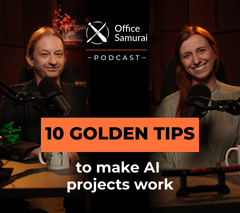Introduction: The digital treasure hunt
Konnichiwa! Welcome to the AI Automation Dojo, the show that looks at your workday and asks “Where did all that time go and can I get it back?”. Today we’re going on a digital treasure hunt for your most valuable and most stolen asset: your time. We’re talking about all the invisible, soul crushing work that clogs up your day. Ever wonder how much of your day that stuff actually eats up? If you could get all the time back what would you do? Solve word hunger? Learn to play the ukulele? Today we’re going to talk about the technology called task mining. It sounds a bit like something you do in a video game but I promise it’s even more exciting. Okay maybe not more exciting than slaying a dragon, but it pays better and the armor is way more comfortable.
I’m your host Andrzej Kinastowski, one of the founders of Office Samurai, the company that dares to ask “What if we fix the work instead of just blaming the workers?”. So whether you’re a manager who suspects their team is busier than they are productive or you’re just tired of your mouse clicking finger getting more of a workout than your brain, you’re in the right place. Now grab your coffee or if it’s been that kind of a week maybe something stronger and let’s get to it.
What is task mining?
Task mining it sounds corporate and complicated but the idea is surprisingly simple. At its core task mining is a technology that uses software to watch how people use their computers to do their jobs. It records things like mouse clicks, keyboard entries and which applications are being used. It’s like having a super smart, incredibly discreet observer standing over your team’s shoulders, thinking notes on everything you do, except without the awkward breathing sounds and judgment. Think of it like a sports analyst breaking down game tape frame by frame to see why a play worked or failed. And it’s not about blaming the player it’s about understanding the game. The goal is to get a crystal clear data driven picture of how work actually gets done. Not how the training manual says it gets done, not how your manager thinks it gets done, but how it really happens in the messy chaotic world of a Tuesday afternoon when the coffee hasn’t kicked in yet.
So how does it work? A small piece of software often called an agent is installed on an employee’s computer. Although with the raise of AI it looks like the term agent might have been taken over, so you will see terms like scout or connection up. This agent then captures the user’s interactions. Now before the privacy alarm bell starts ringing in your head let’s be very clear, this is all done with security and privacy as a top priority. The data can be anonymized, meaning user Andrzej Kinostowski could become agent 007. It could be aggregated at team level, so you know what happens inside the team but not at user level. Companies have very granular control over what data and in what way is being captured by the software. They can specify which applications to monitor like your ERP, CRM, Excel or custom internal software and which to completely ignore like Spotify, personal email or that fantasy football league you are definitely not managing during work hours.

So no, your boss won’t see you shopping for shoes on your lunch break unless you’re doing it in a company official purchasing software in which case you’ve got bigger problems and this podcast can help you. Once this data is collected a healthy dose of AI and machine learning gets thrown at it. The system sifts through all those clicks and keystrokes to identify patterns. It starts to recognize repetitive tasks like okay every time an invoice email arrives from this vendor this person opens Excel, copies these three fields, pastes them here, then opens a separate payment portal, logs in, re-enters the same three fields and then saves a confirmation PDF to the specific folder. It sees all the variations, all the exceptions and all the time it takes. It does this across teams and departments to fight common workflows and more importantly common frustrations. It does require human expertise too. We can set up processes in the tool so we help it understand this glorious mess we humans juggle during our work days.
Task mining versus process mining
Now you might have heard of a similar term process mining. It’s important to know that difference as a lot of people mix those two up. Think of it this way: process mining is like looking at the GPS map of a delivery route. It shows the major stops, the warehouse, the drop off points, the final destination. It sees that the truck left the warehouse at 9:00 a.m and arrived to the first stop at 10:00 a.m. It gets its data from big enterprise systems like CRM or ERP. It gives you the end to end view of the things that are happening inside your main system but most of the time it is blind to anything that happens outside of it. And my experience from working in business processes is that unfortunately at least half of the time we are not working in our ERP but rather inside an email, spreadsheet, messaging app and so on.
Task mining on the other hand is like putting a camera inside the delivery truck. It shows you how the driver is actually driving. It sees them hitting traffic, taking a detour because of construction, getting out to check the address. It sees them spending 10 minutes trying to get a signature on a cracked tablet screen and maybe stopping for a burrito at lunchtime. It’s the ground level view of all the individual steps within each stop on the map. I am as some of you may know a bit skeptical of process mining. Not because it doesn’t work mind you, it does. It’s rather because in so many cases companies who have successfully implemented it will tell you this: it took three times longer than expected, cost twice what was budgeted and in the end we got half of the promised result. Task mining in my humble but well informed opinion gets you amazing results really really fast compared to process mining.
Now as you can imagine a technology that promises to find and fix hidden problems is pretty popular. The market for those tools is booming. It feels like every other week a new company pops up promising to revolutionize how you work. This isn’t happening in a vacuum. The push for digital transformation, the massive shift to remote and hybrid work and the constant pressure on companies to do more with less have created a perfect storm. Everyone is looking for an edge. You have the big established players in automation and software and you have a whole host of newer innovative companies coming in to take a bite of the apple. It’s a classic tech story: rapid growth, lots of competition and a whole lot of buzzwords. But that competition is great for customers. It drives innovation, pushes prices down and forces these companies to build better, more user friendly software. It’s dynamic, it’s a bit chaotic and it means there are a lot of options out there.
KYP.ai: A productivity intelligence platform
So instead of giving you a laundry list of names you’ll immediately forget I thought it would be more useful to focus on the capabilities. To do that we’re going to zoom in on one company that’s taking a really interesting approach to the whole thing. The company is KYP.ai and it’s our favorite task mining vendor. And believe me we have checked a lot of alternatives. And they don’t just call themselves a task mining tool, they call themselves a productivity intelligence platform, which yes sounds like something cooked up in a marketing lab. But when you dig into what they do it starts to make sense.

Their whole philosophy is what they call productivity 360°. The idea is that true productivity isn’t just about the process it’s about three things: the people, the processes and the technology. You have to understand how all three interact. So it gives you a holistic view. For example you might discover a process is slow. A simple tool might just say this process is slow, but the 360 degree view might show you that the process is slow because the software technology is 10 years old and crashes twice a day and because of that the employees so people have created a complicated 20 step workaround a process in Excel just to get their jobs done. You can’t fix the problem without seeing all three parts of it.
One of the biggest differentiators is that they are automation and AI agnostic. That’s a fancy way of saying they don’t care what you use to fix a problem. A lot of tools are owned by automation companies, so surprise surprise their main recommendation is always automate this with our expensive bot. KYP.ai on the other hand might identify an opportunity for RPA, but it might also suggest a training program, a change in the process or even just getting people a better piece of software. They’re not selling the cure they’re just diagnosing the illness. It’s the difference between a doctor who owns a pharmacy and only prescribes their own drugs and one that gives you the best treatment regardless of who makes it.
Another key feature is real time visibility. This isn’t a one time study that gives you a report that gathers dust on a shelf. Their dashboards are live constantly pulling in data so managers can see what’s happening right now and track the impact of changes over time. This makes it not only a tool to make a snapshot of the as-is state, but one to actually monitor and manage your operations over long periods of time. They also have automated process mapping which automatically creates visual flowcharts of how work gets done. And this is huge. Most company’s official process maps are beautiful works of fiction stored in a dusty binder, written years ago by someone who left the company and bearing no resemblance to reality. This tool gives you a living, breathing, digital map of what’s actually happening.

Then there’s the generative AI business case builder. This is really cool. Once the platform identifies an inefficiency it helps you build a business case to fix it. It qualifies and quantifies the potential savings in terms of time, money and FTEs (that’s full time equivalent for those of you who do not speak fluent corporate speak and three letter acronyms). It helps you prioritize so you can go after the changes that will have the biggest impact first. It turns a vague complaint like “this system is slow” into a concrete proposal: “we can save 400 hours per month equating to 150,000 a year by implementing this specific change”. And they have something called Concierge. I don’t have that much experience with this feature, it’s quite new, but basically you can chat with your data. A manager can literally type in a question like “how much time does my team spend on invoice processing and which step takes the longest” and get an instant answer with a chat. It’s like having a data analyst on call 24/7 and one who never gets tired of your stupid questions. They have examples from finance, HR, customer service, basically any department where people sit in front of computers all day, which these days is pretty much all of them.
Real world benefits of task mining
I want to tell you about some real world benefits that we have seen achieved with task mining. A big one for any manager is enabling smarter workload balancing. In any team you have people who seem to be drowning in work and others who let’s just say they have more contemplative time.
And if you think workload in your teams is well balanced, I have 20 years of experience in Continuous Improvement that says you are probably delusional. This isn’t just about fairness it’s about resilience. You can balance the workload not just between individuals in a team, but also between different teams. It moves you from managing by gut feeling to managing by data. By shining a light on those hidden bottlenecks you can start to eliminate them.
Based on the task mining data you can standardize your processes so that everyone is following the best, most efficient path, not just their own quirky workaround invented 10 years ago. This means less time wasted and more time spent on valuable work, you know the work you actually hired people to do.
For many companies the reason to implement task mining is to enable accelerated digital transformation and automation. So many companies want to automate but they don’t know where to start or they have already automated all the low hanging fruit, all the obvious processes and they struggle to find more cases for their automation program. It often becomes a source of huge frustration and a guessing game in a boardroom with the highest paid person’s opinion winning out. Task mining gives you a data driven road map. It builds a pipeline of the best automation opportunities prioritized by the potential ROI. It will show you where opportunities for robotic process automation lie and with the rise of agentic AI it will also show you which processes may need an AI agent. And it allows you to measure the impact after the fact so you can prove that your fancy new robot is actually doing what you paid for it. It takes the guesswork out of the transformation and replaces it with data. KYP.ai even has this feature that can generate agent prompts for a process it observed. Does it work? I don’t know yet but the idea is cool as hell.

Then there are major cost savings to be realized. Now this is the language executives love to hear. When you reduce the hours spent on manual work you get what’s called FTE savings. And let’s be clear this doesn’t have to mean firing people, it means freeing up human potential. It means that employees who were spending 20 hours a week copying and pasting can now spend the time talking to customers, analyzing data or innovating. It also means lower operational costs and better resource allocation. You’re not just throwing people at the problem, you’re fixing the problem itself. And with task mining you will find a lot of stupid repetitive tasks your people do. One of my favorite views in KYP.ai is a copy paste table which basically shows you how much your people are using Ctrl C, Ctrl V and which applications they copied the data from and to.
There is a great example I’ve seen in an insurance company where people were using sticky notes application a lot and copying pasting data from these sticky notes into their ERP system. After this was found in the data, closer investigation showed that their ERP system was so slow that when they were on a call with a customer they were unable to make notes in the ERP system. So they did what humans do, they came up with a workaround. During the call they would make notes on those electronic sticky notes and then after the call they would spend time to copy and paste them into their slow ERP. Now this is a completely idiotic problem to have but our processes are full of cases like this and with a tool that measures your processes in detail you will not only find those cases but will also have solid data to build a business case to fix them.
Another thing you get with task mining and this is a big one that’s more important than ever you get an improved employee experience. Let’s be honest nobody enjoys spending their day copying and pasting data. It’s soul crushing, it’s the kind of digital friction that leads to burnout and has people quietly updating their resumes. When you automate or eliminate those frustrating low value tasks you make work more engaging and more human.
It shows employees you value their time and their talent. It also helps identify where people are struggling. If one person takes 5 minutes to do a task and another takes 30, maybe that second person needs more training or better tools. It allows you further more data driven performance assessment instead of just relying on who looks busy or answers emails the fastest. In the era of remote work, high turnover and lack of resources willing to do entry level tasks creating a better work environment it’s not just nice, it’s a competitive advantage.

And one reason for doing task mining people often do not think about is enhanced compliance and governance. In many industries like finance or healthcare there are strict rules about how certain processes have to be handled. Task mining can ensure that those rules are actually being followed. It creates a perfect, unblinking audit trail. If a process requires a specific four step verification the tool can see if someone skips step three. It can flag deviations from the standard procedures in real time helping to identify and mitigate risks before they become major problems or worse major fines.
And a lot of companies create their own reasons for implementing task mining. One of our customers main reasons for implementing it was to actually create an incentive program for their employees. Every employee performing transactional work now knows exactly how they are being judged and can see where they are based on a dashboard with their own data they can access. So to sum it up there are a ton of reasons to implement task mining and a ton of benefits to reap. It’s one of the few business initiatives that can make both your CFO and your most cynical employee crack a smile, though probably for very different reasons.
Hurdles in implementation
So far I’ve been painting a pretty rosy picture. You plug this thing in, find all the stupid work, fix it and everyone rides off into the sunset on a unicorn. And while it is powerful, let’s be real, this is corporate technology and implementation is never quite that simple. There are a few hurdles you might face but the good news is our experience shows they are solvable.
The first one and the biggest hurdle is the human one, the big brother factor. The moment you say we’re going to install software to see how you work people are going to hear we’re installing spy software to watch your every move. The fear is real. Employees might worry they’ll be punished for not being fast enough or not taking a break. And if people are scared they’ll change their behavior which messes up your data anyway. So how do you fight it? With radical transparency. You have to overcommunicate. Explain the why before you even talk about the how. Frame it as a tool to help them to remove the most annoying parts of their jobs. Show them what the data looks like. Prove to them that you can’t see their fantasy football draft or their messages to their spouse. Make them partners. Ask them what processes drive you crazy, let’s look at those first. When people see it as a tool for them instead of a weapon against them the fear melts away.
Another huge hurdle often the very first one you’ll hit is your own IT security department. And God bless them for it, that’s their job. The moment you mention installing software on every employee’s computer to capture data they’re going to break out in a cold sweat. They’ll start throwing around terms like GDPR, data privacy, security vulnerabilities and they’ll have visions of sensitive company data being beamed to some unsecured server in a foreign land. They’re the gatekeepers and their job is to say no until you can prove it’s safe. And here’s the good news, any reputable task mining vendor is ready for this. They live and breathe this stuff. They’ve built their platforms from the ground up with security in mind. They’ll talk to you about end to end encryption, data anonymization at the source and secure certified hosting environments. They’ll show you their certifications independent audits that prove they have robust security controls in place. They have detailed documentation on GDPR compliance and data processing agreements ready to go. So the key to overcoming this hurdle isn’t to fight it, it’s to bring the vendor into the conversation early. Let the experts talk to experts. Your IT team asks the hard questions, the vendor provides the certified answers and you can move forward with confidence.
The third hurdle is data overload or analysis paralysis. These tools can generate a mountain of information, every click, every keystroke, every second. It’s easy to get lost in it all and end up spending so much time looking at the data you never actually do anything. Tools help you analyze the data, but as it often is, the cure here is to start small and stay focused. Don’t try to fix the entire company at once. Pick one specific painful area to start with. Do a proof of concept, get a quick win, prove the value and then move on to the next problem. Don’t try to boil the ocean.

And the final hurdle is the most tragic one, the report on the shelf syndrome. You do the project, you generate incredible insights, you create a beautiful report with charts and graphs showing millions in potential savings and then it gets put on a digital shelf and nothing ever happens. All that potential wasted. This is a leadership problem. From day one the project needs a team of smart and motivated people and an executive sponsor, someone with the authority to make things happen. It needs a clear owner and it needs to be tied to real business objectives. The goal is not to create a report, the goal is to implement change. So yeah, there are challenges but they’re not technical problems, they’re people and process problems and with a bit of planning and a lot of communication they’re completely solvable.
Final takeaways
Let’s wrap this up. Think about the classic corporate suggestion box, that sad dusty box hanging on a wall, usually empty, occasionally filled with a sarcastic note about the quality of the coffee. It’s a nice idea but it’s fundamentally broken. Why? Because a single anecdotal complaint is easy to ignore. One person saying “This system is slow” or “that process sucks” is just noise. Task mining is the suggestion box on steroids. It’s the suggestion box with a megaphone and an army of accountants. It takes that one person’s complaint and backs it up with data from a hundred other people. It proves that the problem they identified isn’t just an annoyance, it’s a problem that costs the company a thousand hours a month. It turns whispers in the hallway into a data driven argument that’s impossible for leadership to ignore.
So the takeaways:
- Task mining is a megaphone for your employees. It doesn’t just find inefficiencies, it validates the daily struggles of the people on the front lines. It proves they aren’t just complaining, they are identifying real costly problems.
- Task mining is the ultimate bullshit detector. Every company has its official fairy tale story about how work gets done. Task mining cuts right through that and shows the messy, complicated, workaround filled reality. It replaces corporate fiction with data driven facts.
- The real goal here isn’t just about efficiency, it’s about sanity. The ultimate ROI isn’t just a number on a spreadsheet, it’s a workforce that isn’t being actively driven mad by bad workload distribution, broken processes and terrible software. It’s about creating a place where people can actually do their jobs instead of struggling all day.
So here’s my final thought for you. Don’t just ask “How can we be more efficient?”. Start by asking “What is the one thing my team complains about constantly?”. And then imagine if you could walk into your boss’s office and prove in dollars and cents that they’re absolutely right. That’s the power we’re talking about. And that’s a wrap. We’ve officially mined all the tasks we can for one episode. Congratulations on reaching the end of another AI automation dojo. Your dedication to avoiding actual work by listening to a podcast about work is truly inspiring.
Domo arigato for tuning in. Whether you were listening intently or just had this one on in the background to make it look like you were on a very important, very long conference call, we appreciate your time. We’ve been monitoring your engagement and the data looks promising. Massive thanks to the human element that keeps this show from being a series of error messages and Anna Cubal our producer, the one who wrangles my chaotic process without needing a software license. And of course we recorded this in the mighty Wodzu Beats Studio, our dojo for trying to make sense of it all one podcast at a time. If this episode made you want to start investigating your own team’s digital footprint do us a favor: subscribe, leave a five star review and share this with a colleague who you know spends way too much time copying and pasting. Follow us on social media where our process for creating content is let’s call it agile. You got a question, a story about the truly soul crushing task you once had to do or maybe you just want to send us a screenshot of your most ridiculous workaround, drop us a line, we live for this stuff. Until next time keep your data clean and your work meaningful and for the love of all the disproductive stay away from the sticky notes. Mata ne!




